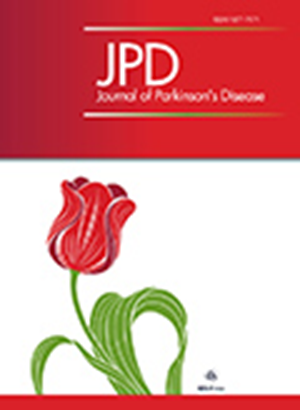Terminal Care in Parkinson’s Disease: Real-Life Use of Continuous Subcutaneous Apomorphine Infusion to Improve Patient Comfort
IF 4
3区 医学
Q2 NEUROSCIENCES
引用次数: 0
Abstract
Background: There are currently no recommendations on the therapeutic management of Parkinson’s disease (PD) patients at the end of life. Objective: To describe a cohort of patients with PD who benefited from continuous subcutaneous apomorphine infusion (CSAI) initiation at the end of their life as comfort care. Methods: This real-life cohort includes 14 PD patients, who benefited from 24-h, low-dose CSAI (0.5–3 mg/h) in the context of terminal care. Patient’s comfort (pain, rigidity, and/or ability to communicate) and occurrence of CSAI-related side-effects (nausea/vomiting, cutaneous and behavioral manifestations) were evaluated based on medical records. Results: All patients (age 62–94 years, disease duration 2–32 years) presented with late-stage PD and a compromised oral route. Treatment lasted from a few hours to 39 days. CSAI led to substantial functional improvement, with a good safety profile. Overall clinical comfort was deemed improved by the medical team, the patient, and/or caregivers. Conclusions: CSAI might be a promising approach in PD terminal care, as it reduces motor symptoms and overall discomfort, with an apparent good safety profile. Use of the apomorphine pen, sublingual film or a classic syringe pump might be considered when apomorphine pumps are not available. Larger observational cohorts and randomized controlled trials are needed to establish the efficacy and tolerability of apomorphine in the context of terminal care and more broadly, in an advance care planning perspective.帕金森病的临终关怀:持续皮下注射阿扑吗啡改善患者舒适度的实际应用
背景:目前还没有关于帕金森病(PD)患者临终治疗管理的建议。研究目的描述一组帕金森病患者在临终前作为舒适护理开始持续皮下注射阿朴吗啡(CSAI)的情况。研究方法该真实队列包括 14 名帕金森病患者,他们在临终关怀中受益于 24 小时低剂量 CSAI(0.5-3 毫克/小时)。根据医疗记录评估了患者的舒适度(疼痛、僵硬和/或交流能力)以及 CSAI 相关副作用(恶心/呕吐、皮肤和行为表现)的发生情况。结果所有患者(年龄 62-94 岁,病程 2-32 年)均为晚期帕金森病患者,口服途径受限。治疗持续了数小时至 39 天。CSAI 大幅改善了患者的功能,并具有良好的安全性。医疗团队、患者和/或护理人员都认为总体临床舒适度有所提高。结论:CSAI 可减轻运动症状和整体不适感,安全性明显提高,因此可能是一种很有前景的帕金森病临终关怀方法。在没有阿扑吗啡泵的情况下,可以考虑使用阿扑吗啡笔、舌下含片或传统注射泵。需要进行更大规模的观察性队列和随机对照试验,以确定阿扑吗啡在临终关怀中的疗效和耐受性,更广泛地说,是从预先护理规划的角度来确定阿扑吗啡的疗效和耐受性。
本文章由计算机程序翻译,如有差异,请以英文原文为准。
求助全文
约1分钟内获得全文
求助全文
来源期刊

Journal of Parkinson's disease
NEUROSCIENCES-
CiteScore
8.40
自引率
5.80%
发文量
338
审稿时长
>12 weeks
期刊介绍:
The Journal of Parkinson''s Disease (JPD) publishes original research in basic science, translational research and clinical medicine in Parkinson’s disease in cooperation with the Journal of Alzheimer''s Disease. It features a first class Editorial Board and provides rigorous peer review and rapid online publication.
 求助内容:
求助内容: 应助结果提醒方式:
应助结果提醒方式:


